Retail
Why People Buy. Mastering the Psychology of Retail in 2016 - Part 1
Lorem Ipsum is simply dummy text of the printing and typesetting industry. Lorem Ipsum has been the industry's standard dummy text ever since the 1500s,
Lorem Ipsum is simply dummy text of the printing and typesetting industry. Lorem Ipsum has been the industry's standard dummy text ever since the 1500s
Middle
Right
10 %
REVENUE INCREASE
10 %
REVENUE INCREASE
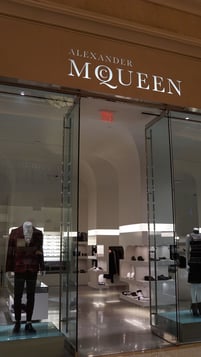 Because before you can sell, you need to know why they buy.
Because before you can sell, you need to know why they buy.
Companies will spend years and years trying to craft the perfect product that consumers simply won’t be able to resist. But before you can effectively sell and market your product, it’s important to understand why we feel the need to buy in the first place. Throughout this article we’re going to delve into the buyer's brain and explore the effect that psychology has on the retail experience.
The Buyer's Brain
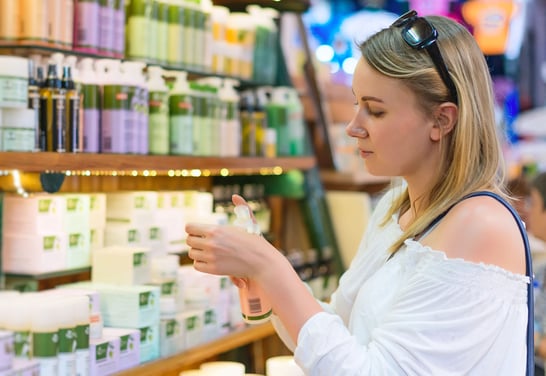
By trying to understand the way in which the buyers brain works we are engaging in a field of work by the name of ‘neuromarketing.’
It sounds quite invasive doesn’t it? Our brains are extremely personal to us and I’m sure many wouldn’t like the idea of retailers being one step ahead of us because they understand our brains better than we do.
However just like anything complex, such as the universe, the brain is going to be researched and explored in every possible way. Therefore retailers can either embrace this powerful form of Jedi marketing or risk losing touch with their customers.
One section of the brain that plays a part in day to day buying decisions is the ventromedial prefrontal cortex (VPC), don’t worry we’re not going to get overly technical on you. Research has shown that when you are considering a purchase, the VPC weighs up the positives and the negatives on offer.
Sounds simple enough right? All you need to do is offer great products at sensible prices and the brain will give you a big thumbs up.
However that is simply not the case.
In fact it’s actually claimed that 90% of purchase decisions are made subconsciously.
So this is where it all starts to become a lot more interesting. How do you set about marketing to the subconscious?
Emotions & Senses
Emotion is the key driver behind the majority of these subconscious buying decisions. The smell of coffee or bacon, the launch of a new iPhone, these can all trigger purchase decisions driven largely by emotions.
We make far too many choices on a daily basis to rely on conscious thought, it would make us incredibly inefficient.
Therefore the more senses you can trigger through your products and services, the more you will appeal to your customer’s emotions and influence their purchasing decisions.
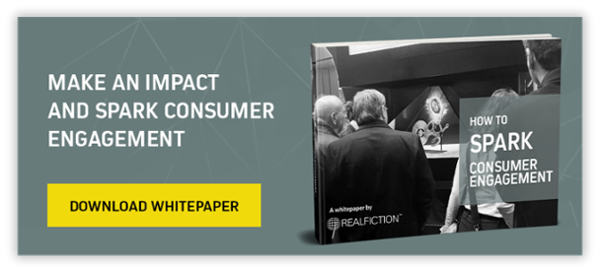
Rather than appeasing the logical part of our brain with two for one deals and discounts, retailers are better off targeting customer emotions with supercharged user experiences and positive brand messages.
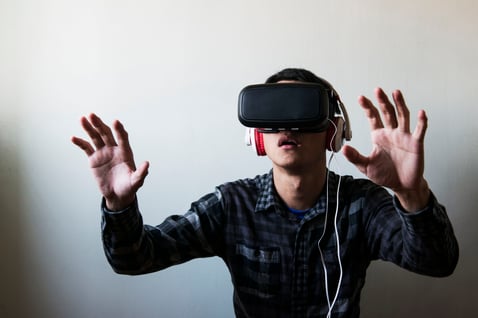
Take North Face for example, they offer customers the chance to try a virtual base jump in their stores. Is that going to make them feel the need to instantly purchase a rucksack, coat and new tent? Absolutely not, however it will creative a positive user experience that the customer will associate with the brand going forward.
This is all part of an emerging trend where retail stores are transforming themselves into playgrounds that offer experiences that can’t be replicated in the online world.
This is just one of the necessary steps that retailers are taking to rescue the in-store experience (link to other post once live).
The Journey
Turning your store into a highly stimulating playground is one thing, but what should that store look like? Should you be taking your customer on a journey the second they walk through the door?
It’s actually been proven that customers take a little while to adjust to the retail experience. Therefore the first area of a shop that you walk into is known as the ‘decompression zone.’ This area is the first impression customers have of the store so it has to make them feel as comfortable as possible. It’s often used for promotions, or cardboard cutouts of David Beckham, despite customers usually overlooking this area.
Once you’ve passed through this decompression zone, that’s when you become a pawn on the retailers chessboard and the psychology of the store layout comes into play.
Ever wondered why fruit and veg is often the first aisle you come across as soon as you enter a supermarket?
It’s because if you purchase your healthy, natural food first it puts you in a positive frame of mind where you’ll feel less guilty about treating yourself further along the shop.
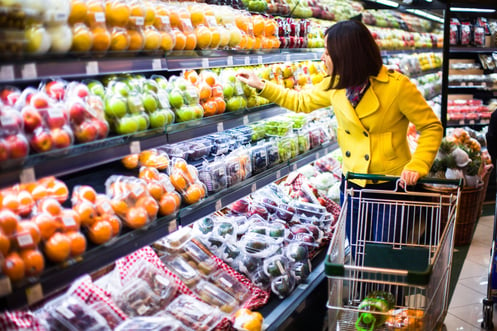
Flowers work in the same way. Bright colours and fresh smells create the impression of a healthy natural store that you feel happy to use for your groceries.
This again links back to our subconscious. We make buying decisions based on our frame of mind which can easily be influenced throughout our journey around the store.
Another example of this is placing popular items in the middle of aisles or deep within a store so that you have to browse more items on your way to what you’re looking for. By increasing the time customers spend in store you increase the likelihood of further sales.
So how can you encourage your customers to spend more time in your store?
Dwell Time
Dwell time is the amount of time a customer spends in your store, and it’s a key metric to look at when reviewing the in store experience you’re offering your customers.
Pathintelligence published a report that shed some light on the correlation between time spent in store and the volume of sales. The report indicated that if you can increase your customer dwell time by just 1% then you could see a 1.3% rise in sales.
Hang on a minute.
Let’s take a customer who would typically spend 60 minutes in a clothing store spending roughly $100. If they spent an extra 6 minutes in the store then, in theory, that spend could go up to $113.
Now let’s say you can add that 6 minutes extra dwell time to 100 customers on a daily basis. Theoretically you could be looking at an extra $1,300 a day.
Of course there are numerous limitations to this theory such as the average spend differing between customers and the price of goods within the store, however even if it applies to a handful of customers it’s certainly worth exploring.
So what’s the best way to increase dwell time?
In the past a favourable strategy was to deploy sales staff to engage customers. But that’s counter productive if anything because it takes customers away from their own personal shopping journey.
If you want to increase customer dwell time in 2016 you need to look towards new technologies that can excite and stimulate shoppers.
Think of the retail experience like being sat on a train and looking out the window. Shelves and shelves of products is like seeing trees, trees, bushes, houses, houses and more trees. Sure you’re observing it but you’re not actually absorbing anything. Subconsciously you want to see more.
You need to snap your customers out of autopilot and give them a reason to pay attention.
The Alexander McQueen store in London has touch screen tables which then project the images onto larger screens in the store. Buyers in 2016 like to feel in control and make their own decisions, which is why this sort of stimulation is far superior to sales staff directly engaging customers.
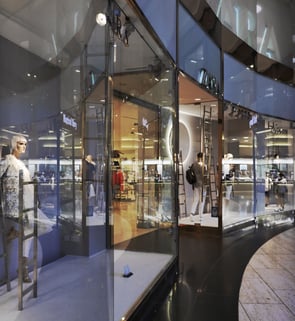 To create an unparalleled in store experience that can increase dwell time retailers need to forget about the sale. By focusing on return on attention customers will leave with positive memories of your brand nestled deep within their subconscious ready to influence them at a later date.
To create an unparalleled in store experience that can increase dwell time retailers need to forget about the sale. By focusing on return on attention customers will leave with positive memories of your brand nestled deep within their subconscious ready to influence them at a later date.
Retailers will soon be able to harness the power of dwell time even further through using beacons to monitor which sections customers spend the most time in and their choice of route around the store.
Many retailers at the moment will be manually monitoring metrics such as footfall and dwell time. However the future of retail is precise data recorded in store by a multitude of technologies that will allow deeper insights into the psychology of shopping and the buyers brain.
If you’re able to combine stimulating in store experiences with a strategic layout then your customers will be happy to invest time into both your store and your brand.
So why do we buy?
Because if we’re not already in a buying state we are often encouraged into one by our surroundings.
By increasing dwell time and mapping out an in store journey, retailers create more time to influence customer emotions and appeal to the habitual, subconscious desires of today’s consumer.
Whether through in store marketing, a friend on snapchat, a TV advert or a magazine, products are constantly rammed down our throats. If anything you could argue that consumerism works on the laws of probability. When you consider how much we buy in relation to how much is offered to us we could almost convince ourselves that we’re actually quite restrained?
Let’s not take it too far.
In Part 2 . . .
In part 2 of ‘Why People Buy’ we’ll be looking at the influence that colour has on buyers and exploring whether it’s the product or the purchase that brings the most joy to the shopper.